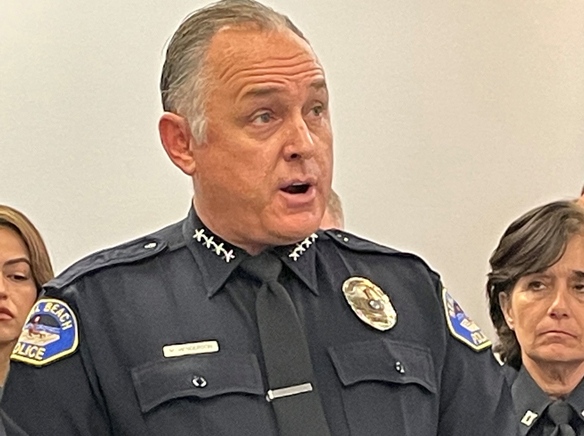The Seal Beach Police Department last week hosted police chiefs from throughout Southern California along with a legislative delegation gathered to express deep frustration about the lack of legislative progress in combating the state’s growing fentanyl crisis.
And, according to Chief of Police Michael Henderson, “the City of Seal Beach has not been immune to the terrible impact of this epidemic.”
“During the last few years, we’ve seen tragic overdoses involving those who have either intentionally or mistakenly ingested fentanyl and have shared in the pain with families who have lost loved ones,” the police chief said at the press conference.
He said legislative inaction and other factors have left communities like Seal Beach almost feeling helpless in the fight against fentanyl.
“Many people in Seal Beach and other small communities across the country are left feeling helpless and overwhelmed by the scale of the crisis,” said Henderson.
Accordingly, the chief said the SBPD is taking “proactive” steps on its own to combat this “epidemic.”
“The Seal Beach Police Department has developed several programs to help us address the issue in our community,” he said.
“These programs include increased public awareness and social media campaigns, a dedicated community-oriented policing team that builds relationships with our school children, and the annual participation in Red Ribbon Week, which helps to discourage drug use, even at the elementary school level,” said Henderson.
The chief also credited its Naloxone program as being of the most successful weapons yet in the fight against fentanyl.
“Naloxone, also known as Narcan is a medication that can influence the cost of an opioid overdose,” he said, “and our officers and professional staff always carry it with them. We’ve seen positive results from this program as our officers have been able to save lives by administering Narcan in acute overdose incidents.”
Additionally, he said, in partnership with the Drug Enforcement Administration, the city hosts drug takeback events twice a year to help ensure that unused medications do not end up in the wrong hands, “especially those of children and young adults.”
Even though the city is aggressively countering the fentanyl crisis, Henderson said the department cannot alone solve the problem.
“Despite these proactive programs, the Seal Beach Police Department cannot solve this problem. We need bipartisan support from our elected officials to ensure that we have the resources we need to combat this epidemic,” he said.
In addition, the police chief said “we also need strong leadership from our community stakeholders to raise awareness about this issue and encourage residents to take an active role in preventing overdose deaths. We believe that community involvement is key to addressing this problem.”
Henderson encouraged all residents to learn more about the dangers of fentanyl and to “take steps to safeguard their families and loved ones.”
This includes properly disposing of unused medications, seeking help for addiction, and recognizing the signs of an overdose.
The department is committed to addressing the issue through programs and partnerships with all of their law enforcement partners, Henderson told his fellow officers, legislators and OC Sheriff Don Barnes.
“The fentanyl epidemic is a stark reminder of the urgent need for comprehensive and compassionate solutions to the problem of drug addiction and overdose,” the Seal Beach police chief told the group.




